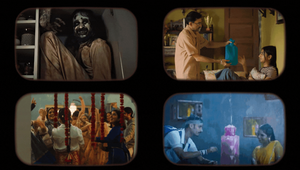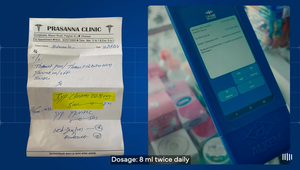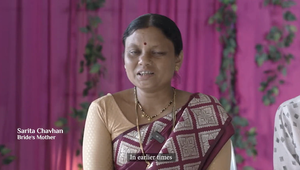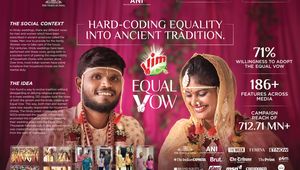
5 Minutes with… Varun Anchan

Executive creative director at Lowe Lintas, Varun Anchan is an expert in the digital realm, where the convergence of creativity and innovation redefines the future of brands. He is passionate about building innovative platforms, products, and engaging experiences – and his recent Silver Cannes Lions for ‘DawAI Reader’ (India’s first metal in the Pharma category since 2018) is proof of his ability.
Prior to joining Lowe Lintas in January 2024, Varun held various creative positions at the likes of Studio X (a Coca-Cola India agency), Dentsu Webchutney, Ogilvy, Flipkart, The Glitch and The 120 Media Collective, as well as photography roles at Hello! Magazine, BBC TopGear India and more.
To get to know the multi-faceted creative, LBB’s Sunna Coleman speaks with Varun about the team’s recent Cannes Lion win, how true leadership lets others shine, and why we need to use technology more thoughtfully.
LBB> You’ve spent over 18 years in advertising but, looking back, when did you realise that it was an industry you wanted to work in?
Varun> Has it really been 18 years already? That’s almost half my life spent in advertising and yet it still feels like I’m just getting started. I never really chose advertising – honestly, I think advertising chose me. It’s like that one clingy friend who refuses to let go.
What drew me in was the thrill of storytelling – the way you can take a raw idea, dress it up with just the right emotions, and deliver it in a way that actually makes someone feel something. Kind of like crafting the perfect burger: one juicy thought, a slice of wit, a dollop of insight... and suddenly people can’t get enough.
For me, the medium never really mattered – TV, digital, print, a tweet at 2 am – what’s always mattered is nailing the message and making it memorable. That constant challenge of figuring out what people want to hear, and how they want to hear it, is what’s kept me hooked for 18 years.
LBB> Are there any defining moments that you feel have shaped your career and led you to where you are today?
Varun> One defining chapter of my career was undoubtedly my time at Webchutney. That experience completely reshaped how I viewed creativity not just as craft, but as problem-solving powered by technology. It taught me to see digital not as just another medium, but as a mindset: a way to reimagine how brands connect with people in more personal, interactive, and meaningful ways.
That mindset of experimentation, agility, and innovation became the foundation of everything I’ve done since. It’s what drives me even today to use technology not as a gimmick, but as a canvas to create ideas that live in culture, solve real problems, and push the boundaries of what’s possible for brands.
At Webchutney, I also learned one of the most important lessons of my career from the CEO at the time, Siddharth Rao: always invest in people. Companies, after all, are nothing but the people who make them. And Webchutney was living proof of that built by a team of individuals who came from all kinds of backgrounds, not necessarily traditional advertising, but united by a desire to challenge norms, use technology and culture in bold ways, and create work that truly connected brands and people. That philosophy of valuing the right people, and creating a space for unconventional thinkers, has stayed with me ever since.
LBB> Are there any career lessons you know now that you wish you’d learned earlier?
Varun> That overthinking is overrated, and experimenting almost always pays off. In digital, if you wait for the ‘perfect’ idea, the moment’s already gone and someone else has tweeted it. Sometimes you just need to jump in, try things, and course-correct as you go.
Another big one: leadership isn’t about being the smartest person in the room, it's about making everyone else feel like they are. I wish I’d learned earlier that doing everything yourself isn’t leadership; enabling others to shine is. And honestly, the sooner you learn to laugh at yourself in this business, the happier you’ll be because nothing ages faster than yesterday’s ‘big idea’.
LBB> As someone who has stayed in India for his whole career, what are your thoughts on the state of Indian advertising as a whole? Is there a great appeal that’s kept you here?
Varun> India is one of the most fascinating, unpredictable, and gloriously chaotic markets in the world which is exactly why I’ve stayed. Here, technology doesn’t just enhance culture, it becomes culture overnight. One day it’s a meme, the next day it’s a movement. That constant dance between human insight and innovation is what keeps the work exciting and me on my toes.
I love the challenge. Where else do you get to create ideas that have to speak to a billion people, in dozens of languages, across every possible device and screen and still somehow stand out? That kind of creative chaos is addictive.
Where else can you crack a campaign in the morning, and by evening it’s already a WhatsApp forward in your family group? You can’t beat that kind of instant feedback.
LBB> You recently won a Silver Cannes Lions for your work on ‘DawAI Reader’. In your personal opinion, what is it about this work that made it such a success?
Varun> Pharma is one of the most competitive and trickiest categories at Cannes, which is why this win feels especially meaningful. From day one, our vision for ‘DawAI Reader’ was clear: to create an AI-driven solution that wasn’t just innovative for the sake of it, but purpose-built for rural India, empowering chemists who are the final, and often most critical, link in the healthcare chain.
It tackled a very real, very human problem: rural chemists struggling for decades to decipher illegible prescriptions, with lives quite literally hanging in the balance. By combining AI, localised language solutions, and a deep understanding of the audience’s reality, we built a platform that was technologically advanced, culturally relevant, and socially impactful.
Winning Silver in Pharma for Product Innovation is more than just an accolade; it's proof that when AI is developed with empathy, expertise, and intent, it can drive meaningful, lasting change. That’s what set this idea apart: it wasn’t just creatively fresh, it was rooted in purpose.
And none of this would have been possible without the people who believed in it every step of the way. I’d like to thank our COO at Lowe Lintas, Prateek Bharadwaj, for constantly backing me and the team at one too many levels, and for his unwavering belief in the power of this idea. And a special mention to Rahul D’Cruz, my unit creative director, whose ability to craft ideas that go beyond gimmicks and create real impact has been a driving force behind the success of this campaign.
LBB> How would you describe your approach to creativity, and to leadership more generally?
Varun> For me, creativity has always started with empathy – really seeing people, not just as consumers or ‘target audiences’, but as humans with messy lives, emotions, and unspoken needs. Then comes the fun part: figuring out how to use ideas and technology to surprise and delight them in ways they didn’t even know they wanted. That little spark of connection. That “oh, they get me” moment, is what keeps me coming back for more.
And leadership? That’s just another kind of creativity, really. To me, it’s about people first, creating an environment where the team feels safe to take risks, brave enough to fail, and bold enough to dream bigger than they thought they could. My job isn’t just to hand them answers, but to push them to ask better questions... and to believe in their own brilliance, even on the days they don’t see it themselves.
If the work we put out feels relevant, and the people who created it feel proud (and maybe even had a laugh or two along the way), that’s when I know I’ve done my job well. Because at the end of the day, great work comes from happy, fearless people – not from spreadsheets.
LBB> Where do you go to find inspiration outside of advertising, and how do you infuse this inspiration into your work?
Varun> For me, inspiration isn’t something you chase, it's something you feel when you’re truly alive and present. Everything around us has the potential to spark an idea, but you can only see it if you’re in the right frame of mind. And that’s something we often forget in today’s world, caught up in the hustle, always connected, always ‘on’ – we forget to just be.
I’ve learned that you can’t create meaningful work if you don’t live a meaningful life. That means carving out time to nourish yourself to have conversations that move you, to listen to music that stirs something in you, to travel, to disconnect, to just sit with your thoughts. Those moments outside of work aren’t a luxury, they're essential. Because you can’t pour from an empty cup.
The more you fill your own life with richness and feeling, the more you can bring that same depth and authenticity into your work. That’s what makes creativity human and worth it.
LBB> What are some current creative trends that you think have staying power? And which ones are a fad?
Varun> I believe utility-driven creativity where brands genuinely add value to people’s lives is here to stay. Today’s audience doesn’t just want to be sold to; they expect brands to solve problems, enrich their lives, and help them express themselves in meaningful ways.
As technology becomes more intuitive through AI, immersive experiences, and personalisation, brands that use it with thought and purpose will continue to earn trust and relevance.
On the flip side, superficial ‘purpose’ campaigns, where brands latch onto causes without genuine investment or impact, are already fading. The audience today is far smarter and sharper; they don’t just engage with brands, they evaluate them. Every claim, every story, every stand a brand takes is scrutinised. There’s simply no room anymore for anything that isn’t authentic or backed by real action.
In the end, the ideas that endure are the ones that respect people’s intelligence, their time, and their emotions because creativity, at its best, is about creating something meaningful, not just memorable.
LBB> In your opinion, what are the main challenges that the industry is facing at the moment, and how can it work to tackle them?
Varun> One of the biggest challenges we face today is the obsession with short-term metrics at the cost of long-term brand building. In the age of instant data and real-time dashboards, it’s tempting to optimise for clicks, views, and quick wins but that often comes at the expense of creating deeper, more enduring connections with audiences. Brands risk becoming transactional, forgetting that trust and love are built over time, not overnight.
Another challenge is how we sometimes treat technology. Too often it’s seen as a gimmick to grab attention, rather than as a powerful enabler to solve real, human problems. When used thoughtfully, technology can elevate creativity and deliver meaningful impact but only if we keep the human at the centre of everything we do.
And finally, we can’t ignore the pressure and burnout the industry places on creative talent. Great ideas come from teams that feel supported, inspired, and safe to take risks not from those running on empty. As leaders, we have a responsibility to build more sustainable, nurturing environments where creativity can truly thrive.
LBB> Looking ahead, what are your biggest hopes for the industry, for Lowe Lintas, and for the kind of work you’d like to create in the future?
Varun> My biggest hope for the industry is that we stop treating technology like a last-minute garnish and start using it like the main ingredient it can be. When used with empathy and purpose, technology has this incredible ability to make ideas more human, more inclusive, and way more impactful. But it only works if we remember what it’s really for: connecting with people.
For Lowe Lintas, what drew me here was its legacy of building some of India’s most iconic and enduring brands. That kind of meaningful, long-term brand thinking is a rare thing these days and it’s what sets us apart. My hope is that we keep building on that foundation but also stay fearless pushing boundaries, tapping into culture, taking bold creative leaps, and helping brands lead conversations instead of just chiming in.
And on a personal note? I want to keep making work that surprises people not just because it’s clever, but because it’s relevant, beautifully crafted, and actually moves them. Work that sits perfectly at the intersection of creativity, technology, and humanity. Work that reminds people why they fell in love with brands in the first place... and maybe even makes them fall a little harder.















